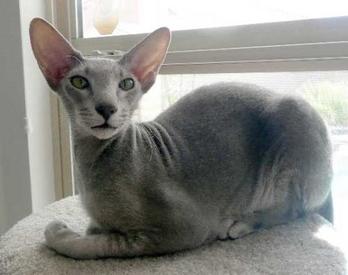
The Peterbald originates from...
Formerly known as the ‘Don Sphynx’ due to its baldness, the Peterbald is believed to have developed in St. Petersburg, Russia, in late 1994. Initially thought to be the result of a dominant genetic mutation causing hair loss, this was later disproved when kittens started appearing with hair. The truth of the breed’s genetics is still contested, but it is quite possible that more than one gene is involved in the mutation, or the gene codes for a coat is sparse or altered in some way. Today it is thought to have descended from the original litter of four, born to a Don Sphynx male and an Oriental Shorthair female. The Peterbald was recognised by the International Cat Association in 2005.
The Peterbald is characterised by...
Depending on the genes of its parents, a kitten can be born with a variety of different coat types. It might appear without a coat entirely, or with very fine hair on the extremities and around the face. Otherwise, the hair might be downy, short and suede-like, kinky, or of varying lengths. A cat of this breed may also be born with a completely normal coat, which may or may not be lost over time. The appearance is similar to that of the Siamese with wide-spaced ears, a long nose, a slender body on long, nimble legs, and slightly oblique eyes. The tail is often described as resembling a whip and is long and narrow. There are many colour varieties and patterns in the breed.
The average Peterbald...
This cat is highly intelligent and active-minded that needs plenty of mental stimulation to lead a happy and fulfilled life. Very vocal like the Siamese, the Peterbald will communicate loudly when it wants your attention. Generally speaking, this breed is harmonious and affectionate, demonstrating love and loyalty towards its family. Some owners and enthusiasts have mentioned that this cat can sometimes act aggressively if confronted with new people or situations and does not appreciate being left alone for long periods of time. On average, a fully-grown Peterbald will weigh 8-10 pounds, with a typical life expectancy of 12 years.
Weaknesses...
Due to the rarity of the Peterbald, determining any breed-specific or genetic health complaints is difficult. There are many people that believe the genetic make-up of the Peterbald makes for an inherently unhealthy breed, although there is little evidence to support this.
Browse more breed facts and information or take a look at our range of scratching and climbing posts, carriers, crates, and pens, and water fountains.
Do you own a Peterbald? Let others know what they're like!
Related products
Advantage 80 Spot On Flea Control Large Cats and Rabbits
from £12.95
Advantage 40 Spot On Flea Control Cats, Small Dogs and Rabbits
from £12.95
Advantage 250 Spot On Flea Control Large Dog
from £12.95
Advantage 100 Spot On Flea Control Medium Dog
from £12.95
Drontal Tasty Bone Wormer Tablets for Small & Medium Dogs (2 to 20kg)
from £2.15
TermaWorm™ Tablets for Cats & Dogs
from £1.79
Drontal Tasty Bone XL Wormer Tablets for Large Dogs (Over 20kg)
from £6.39
Advantage 400 Spot On Flea Control Extra Large Dog
from £12.95